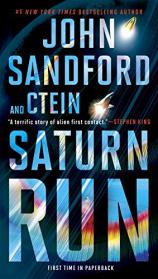Saturn Run
Review
Saturn Run
The first space race was between the United States and the former Soviet Union in the 1960s. Some of us are even old enough to have seen it play out launch by launch on fuzzy black-and-white TV sets. That set the stage for more than four decades of intense orbital competition that drew in more and more countries and private entrepreneurs, yet ultimately generated less and less excitement. Even the engineering marvel of the current International Space Station has become rather routine.
Enter SATURN RUN, the unlikely collaboration of renowned detective novelist John Sandford and Ctein, the single-named prose author and photo artist, who jump a century beyond Sputnik satellites and Apollo capsules into an entirely new space race between America and China. Things are getting exciting again.
This time, the stakes are higher than ever: scientifically, politically and logistically. Its 2066 --- well, within the statistical lifespan of many reading this now --- and the chance discovery of an alien object planted within the rings of Saturn instantly sparks the second seriously world-gripping space race in human history. Who will reach the mystery object first? And what will they (or it) do when contact is finally achieved? What astounding secrets will it reveal?
Sandford and Ctein found their background setting ready-made in the relentless political competition between Earth’s superpowers and the huge espionage industry they feed; it’s almost a given that these elements will still drive global events a mere 50 years from now. So even though the politicians and their subtle operatives are cleverly characterized, that’s not where SATURN RUN is at its most compelling.
"SATURN RUN does an outstanding job of bringing speculative fiction and current theoretical science into close-enough proximity to keep the pages turning. It has not only a steady pulse but also a strong heartbeat."
As any credible sci-fi author or fan will assert without hesitation, it’s usually not the folks who launch rockets that are most interesting; it’s the folks on board, especially if you’re planning a multi-year journey with uncertain prospects for a safe return. When psychology, technology and experimental engineering combine a billion kilometers from nowhere, interesting and sometimes tragic things happen.
Even readers who don’t do “geek talk” well will appreciate Sandford and Ctein’s ability to weave a variety of ultra-skilled but definitely eccentric characters into the still-raw theoretical science of long-distance spaceship propulsion. Simply put, the biggest ship with the most fuel doesn’t necessarily get there first, and they do their level best to tell you why in surprisingly normal-sounding interactions among a colorful but precisely chosen crew. And then they do it again in an accessible and interesting “hard science” epilogue at the end of the book.
Basically, the late 21st-century Americans have one kind of propulsion technology and the Chinese have another. As SATURN RUN deftly illustrates, in the final outcome neither proves superior; the parallel expeditions experience freak accidents, unforeseen setbacks, dangerous maneuvers, tragedy, death and, finally, enforced cooperation. Both cultures are pushing the limits of their technology envelopes, and they know it. And both are obsessed with acquiring the advanced knowledge that unknown aliens are believed to have left parked outside Saturn.
Without entering too deeply into “spoiler” territory, it’s relevant to mention that the alien-built object is a glorified trading-post whose shrewdly programmed artificial intelligence bargains with any species in its own language for unique cultural artifacts (it’s oddly attracted to human non-digital musical instruments and analogue sound recording devices). In return, it doles out vast quantities of data whose ultimate use will take many years to understand. And here is where Sandford and Ctein shape SATURN RUN into a powerful parable of what happens when human greed and impatience clash with old-fashioned ethics and Samaritan instincts.
Their wrap-up of an extraordinary space odyssey that returns home much less gloriously than planned is by no means conclusive. The Americans don’t quite “win,” and the Chinese don’t quite “lose.” The trajectory of their future relationship is precarious, and the question remains open as to whether or not their combined efforts will actually advance the human race in any way, shape or form.
A very real problem on a long voyage, as with a long book, is keeping interest up without creating too many distractions or overloading the story with narrative clutter. And on top of all that, how does one manage to keep an intensely anticipated event like alien contact from becoming anti-climactic?
Despite a few thin areas in its fabric, SATURN RUN does an outstanding job of bringing speculative fiction and current theoretical science into close-enough proximity to keep the pages turning. It has not only a steady pulse but also a strong heartbeat. It will be interesting to see where Sandford and Ctein go next.
Reviewed by Pauline Finch on November 23, 2015
Saturn Run
- Publication Date: February 7, 2017
- Genres: Fiction, Futuristic, Suspense, Thriller
- Paperback: 592 pages
- Publisher: G.P. Putnam's Sons
- ISBN-10: 1101987529
- ISBN-13: 9781101987520






